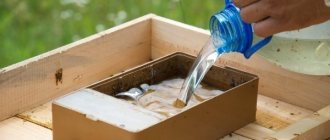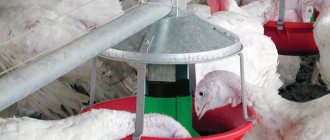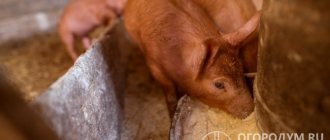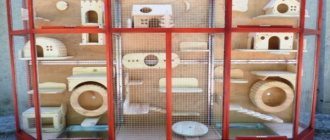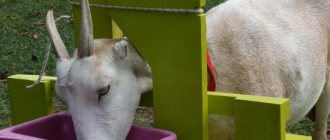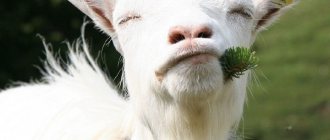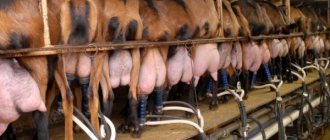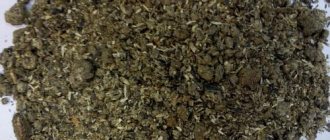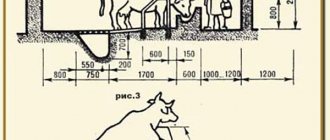With the decision to raise goats comes the question of where to keep them. This should be a room that meets the needs of the wards and is convenient for the owner when caring for animals. You can build a goat shed with your own hands. Even a beginner can do this, provided proper planning and selection of materials. What will need to be taken into account during construction and what materials to stock up on will be discussed in the article below.
Basic requirements for the premises
Keeping goats is not difficult, because these animals are quite unpretentious. They can live next to other livestock and get along well with poultry.
In warm climatic regions in spring and autumn, goats do not need a barn at all; a sufficient condition for keeping them is a shed in a place protected from drafts.
For the winter, they need to be transferred to a more permanent building, where the minimum temperature does not fall below 8 degrees Celsius.
Building a shed for goats separately or allocating a nook for them in a common room is a matter for the owner.
It is economically beneficial when all the cattle are in one building, separated by strong partitions. But still, if there is such an opportunity, it is advisable to build an independent goat house.
Its size is determined based on the planned number of individuals. Ideally, every adult animal should have its own place. This could be a cage or pen.
Adult goats may be kept together. In the barn, it is necessary to provide separate housing for female cats, goats and young animals.
This condition will prevent competition and conflict, make it possible to plan the reproduction of animals and protect the kids from the negativity of the older generation of goats.
Goats adapt to both hot weather and cold weather, but cannot tolerate dampness, so the barn premises must be dry and warm enough.
If built correctly, the goat's house does not require the installation of a heating system, because the animals themselves heat the air to 8-10 degrees Celsius. In addition, provide for sunlight to enter the interior, provide electricity and consider a ventilation system.
It is recommended to attach a pen for walking animals to the barn, provided the temperature outside is 12 degrees Celsius and above. You can feed goats in it.
Stall design
The cage must provide:
- bed for sleeping;
- everything necessary for supplying feed and water;
- natural light, the window cannot be cut down above the sunbed;
- a place (corner) to defecate (goats do not do this where they eat).
Goats, if they are peaceful, can be kept in a group. The goat is always kept in a separate room. In a goat cage, the walls and high partitions are built from thick boards and carefully treated with resin.
The cracks are caulked. Ventilation is installed to remove specific odors.
Goat stalls
The best option is for each animal to have its own cage. If this is not possible, you need to fence a separate area for each goat.
Choosing a place to build
When choosing a place to build a goat house, give preference to a small hill or plain. In the lowlands, the barn will be damp, which means the animals will constantly get sick and waste away.
Before construction, the area for construction must be cleared of vegetation: remove trees and shrubs with maximum uprooting of the root system. After preparatory work, level the area.
Keep in mind that each adult goat needs about 1 square meter. m. area, and for kids - 0.6-0.8 square meters. m. Place the building on site so that the façade and walking pen are located on the south side.
Types of breeds
The agricultural purpose of a goat is to provide humans with meat and dairy products, as well as wool and down.
Consider the popular breeds:
- The Saanen dairy goat is rightfully considered one of the best dairy breeds. She has no equal in milk production - this goat can produce more than 7-8 liters of milk per day. This is a large animal, its height is approximately 77-90 centimeters, and its weight reaches 80-90 kilograms. Almost all goats of this breed are distinguished from others by white short hair, small erect ears and a complete absence of horns. All the calories that the Saanen goat receives from food are spent by its body not on increasing fat deposits, but on increasing milk yield.
- The Boer breed is the most famous representative of the meat goat breeds. It was bred in South Africa. The weight of young goats of this breed ranges around 90-100 kilograms, and adult goats are even larger and heavier - they weigh about 110-140 kilograms. The Boer goat is most widespread in the United States, South Africa and New Zealand.
- There is no person who has not heard about Angora wool. Angora goats are its main producers. Their fur is long and thick, and is most often wavy or curly. The fur grows almost to the ground, covering the animal's legs. The goats themselves are small in size - their weight ranges around 50 kilograms, 6-7 of which is wool. Mass breeding of these animals is common in Australia and some European countries.
- Kashmir goats have such fine, soft and elastic fluff that they have long become suppliers of raw materials for the textile industry. In addition, their down is an excellent thermal insulation material. The lightest openwork items made from Kashmir fluff can be easily threaded through a ring.
- Decorative breeds of goats, mini-goats. These species of artiodactyls were bred to decorate human life rather than to provide food or wool. However, their milk is very nutritious and healthy.
How to build with your own hands?
Depending on the reliability, solidity and time of operation of the building, materials for construction are selected. A capital structure requires much more material costs, effort and knowledge than a wooden structure.
Planning
Approximate diagram of a goat shed:
Planning is the current phase of construction. The plan must contain a clearly formulated goal, include the size of the herd, take into account the peculiarities of climatic conditions and the specifics of the area.
The project must necessarily contain drawings (diagrams) of individual elements of the entire complex with their dimensions. Some adjustments can be made to it as construction progresses.
Foundation
The foundation for a capital building is made using the strip method. To do this, it is necessary to dig trenches around the perimeter of the goat's rue with a depth of about 45-50 cm. Above them, formwork is installed from available material, ensuring a concrete pouring height of 25 cm above ground level.
Concrete mixture is poured into the resulting foundation recesses. Drying the foundation requires time from 3 weeks to a month during a warm, rain-free period.
For a wooden structure, a foundation made of pillars or piles dug across the area of the shed is suitable. Leave a distance between them of no more than a meter.
Remove the turf layer of soil over the area. Dig holes, fill in a bed of screenings and gravel 20 cm thick, and compact it. Install pillars in the recesses, filling them with concrete.
Pouring and laying the floor
For the floor in a solid goat's coop, you first need to make a well-compacted earthen or adobe base.
Next, lay the floors on top from:
- boards;
- flat slate;
- roofing felt and metal sheets.
Another option is to pour the floor with concrete over a bed of cinder or gravel. In this case, it is necessary to maintain a slope of 2 cm by 1 meter so that the urine flows into the sump.
For a concrete floor, it is worth stocking up on a large amount of bedding, since use without it is unacceptable due to the fact that even in summer the floor is very cold.
The optimal method is to install gutters along the floor in the direction of a container for collecting urine and feces, and on top to organize a removable flooring in the form of a wooden grid. Such a floor will be dry and warm, and practically no bedding material will be required.
Construction of walls and windows
The walls are erected from wood, brick, foam and gas blocks, adobe. Stone materials are not recommended - the barn will be cold and damp.
For a wooden structure, timber is used, covered with a board with an internal space of 10-15 cm. To preserve heat in the goat house, these voids are filled with expanded clay, sand, firewood or any insulation. The brick goathouse is plastered for insulation.
Build walls 2-2.5 m high. Don’t go higher, because the large volume of air in the barn will be difficult to warm up in winter. Smooth walls are easy to clean and disinfect.
Place windows and doors on the south side of the building. For safety reasons, the door must be double-leaf and open outward. Opening the top flap, located at a height of 1.5 m above the floor, is a way to ventilate the room.
For a small goat house, one window opening near the door is enough. Large sheds require several windows at a height of 1.5 m. Their number is determined by the ratio of 1:12 to the total area of the building.
Ceiling and roof installation
It is recommended to hem the ceiling with a pitched roof with a board, and use mineral wool, polystyrene foam or other insulation for thermal insulation. Lay a layer of thin plywood on top of it.
The roof must be reliable. An excellent material for it is slate or tiles. A pitched roof is covered with a slight slope so that snow and rainwater do not linger on its surface.
A gable roof will be more expensive, but it becomes possible to organize an attic space where you can store hay, equipment, or use it for other needs. With this roofing option, the ceiling is insulated with a mixture of straw and clay.
Treat all wooden building materials with primers, and impregnate floor boards with drying oil. This way, the performance properties of wood will increase, extending the service life several times.
Brief step-by-step construction instructions
The procedure for building a goat shed is as follows:
- First, we select a place for construction, clear it of weeds and plant roots, and carefully level the soil surface.
- We lay a foundation that must be strong and reliable, regardless of the material for further construction.
- We build walls with several openings for windows and doors (it is advisable to place them on the younger side). In this case, the height of the building should reach 2.5 meters.
- We lay a wooden floor inside the barn, and cover the building with a gable roof on top. Preference should be given to a gable roof, since in this case you will have an attic for storing feed. But it should be taken into account that in order to retain heat during the cold season, the roof must be insulated.
Also in the room you need to install pipes for supply and exhaust ventilation, install stalls, feeders, drinking bowls and nurseries.
This is a general algorithm for constructing a building for raising goats. Let's consider all its stages in more detail.
For milking
Milking a fidgety goat will be much easier if you equip a special machine in which the nurse is placed while expressing milk from her udder.
Variations of the machine may vary, but the basic parts are always the same. During the milking process, the goat will stand on a platform of 3 wide wooden boards 2.5 by 18 by 120 centimeters; legs (4 or 6) with parameters 5 by 10 by 30 centimeters are used to support it. You will also need: a pair of bars with parameters 5 by 5 by 10 cm, a pair of sidewalls 2.5 by 10 by 120 centimeters, a pair of end parts 2.5 by 10 by 50 centimeters. The device is sequentially assembled and attached to the side wall of the stall. Each sharp edge is processed separately so that the goat is not injured. Be sure to build a clamp that will hold the animal's head. With a portable or folding version, it is convenient that you can milk the animal outside.
Necessary communications
If communications are laid out incorrectly, then all efforts to build a goat shed may become futile. Animals cannot be in uncomfortable conditions. Therefore, treat this stage of construction responsibly.
Ventilation
Ventilation will ensure ventilation of the room, access to oxygen inside and maintain the level of air humidity inside.
The simplest supply and exhaust form of ventilation consists of:
- pipes with a diameter of 100 cm or more, installed in the center of the roof or under the ceiling in the far corner of the barn;
- pipes above the floor near the front door.
To prevent drafts, debris and rodents from entering the shed through the ventilation, the pipes are covered with protective flaps.
The optimal level of air humidity in a goat shed is 70-75%.
If the area of the goat's rue is large, it is recommended to install an automatic ventilation system.
Lighting
The level of indoor illumination is very important for goats, especially for young animals. In addition to natural lighting, place electric lamps indoors. They must be at a height inaccessible to animals and protected by a grille or shade.
Shelves
Goats love to sleep on dry, raised wooden floors. Such shelves are nailed to the walls at a height of about half a meter. You can assemble them from boards with your own hands. They can be insulated for the winter.
The width of such a bed for goats is 60 cm, the length is at least 80 cm per animal. This area will provide comfort and reduce the likelihood of injury.
Heating
Heating is necessary only in areas with cold climates, where maintaining the indoor air temperature at 8-10 °C without the use of additional heat sources is impossible.
The use of a stove in a barn is prohibited. It is recommended to install steam heating with a boiler in a separate brick shed.
Manure removal
Cleaning and manure removal should be done twice a day. This will protect livestock from developing infections, maintain hygiene and maintain humidity levels at the proper level.
If there are pallets, they are taken out and washed. A system is often used where a ditch is made under one wall to rake manure into it, followed by cleaning.
Floor
The goat is considered an unpretentious representative among domestic animals. But the individual carefully selects the place where she will sleep. A cold concrete floor must be covered with boards, and the floorboards must rise 20 centimeters above the cement. Then it is covered with a thick layer of straw, dry leaves or wood shavings. To ensure that the liquid drains and does not stagnate in the barn, the boardwalk is laid on a slope; each meter of floorboards corresponds to a couple of centimeters of slope. To drain liquid manure, something like gutters are installed on the sides of the room, and a collection pit is dug away from the stall.
In addition to bedding, in the place where the goat sleeps, you need to put a solid board. The bed is installed 50 or 60 cm from the flooring level. The width of the stick should be within 60 centimeters, the length of the board for resting the goat is 80 cm.
Arrangement of the premises
A properly equipped goat shed will provide comfort to the animals and convenience to the owner when caring for his charges.
Stall
The general space allocated for stalls can be divided using wooden partitions no more than 1.5 m high. If individual stalls are planned for each goat, then their optimal size is considered to be at least 2 × 1.5 m. In such pens, animals are kept without leashes.
Crowding when keeping a goat affects its general condition and reduces milk production.
Make the front wall in the form of a door with reliable awnings and latches. Place a nursery on the inside surface of the door to optimize space and ease of feeding. This way you won’t have to go inside the table every time you feed the goats.
Floor mat
Use straw or sawdust as bedding. They will protect animals from the cold floor, if it is not covered with wood, and will additionally absorb moisture. Don't skimp on bedding. This will protect the goats from various infections and inflammation of the udder.
Manger and feeder
The nurseries are designed for putting hay and grass in them, and concentrated feed, vegetables and fruits, mash porridge, etc. are poured into the feeders.
Goats often spoil hay and other feed by sorting, scattering and trampling it.
To prevent such wastefulness from happening, provide a comfortable manger and feeders in the barn, located suspended 0.5 m from the floor. Place a tray under them so that the food falls into it and not onto the floor. Later it can be poured again for animal food.
Small sides on the feeders will also be useful.
The nursery needs space for salt rock and mineral supplements. Take this into account when planning the size so that the goats do not later throw out hay in an attempt to get to the salt.
Stall
The milking machine makes it easier to milk a goat, ensuring its immobility during the process. You can buy it ready-made or make it yourself from wood.
The milking machine is a kind of box made of thin timber with a feeder at the head and the ability to fix the animal's head. Often this part has a tighter space that does not allow the goat to turn its head during milking.
The design must be reliable and have a ladder so that animals can safely climb to the height of the pen. You need to install the milking cage in the quietest and most peaceful place in the goat barn.
Approximate drawing for the machine, photo:
If automatic milking is provided, then there must be a place near the machine for the machine and containers, and you also need an electrical outlet and sufficient lighting.
Fencing
Some goat breeders very skillfully equip an outbuilding as a stall for animals. For one large goat or a pair, or even three goats that get along with each other, 3 or 4 square meters is enough.
Provided that not the entire building will be used for the stall, it will be necessary to properly manufacture and install the enclosing structure. You need to understand that there should be no horizontal ledges on the wall. If you use a welded fence, the fencing reinforcement must be positioned vertically. Moreover, the entire perimeter is covered with fine mesh, which is tightly tied to the fence with wire. If you neglect the mesh protection, goats can damage their limbs when they crawl into the space between the bars, or they crawl through and end up where they don’t want to go.
The fence must be secured with posts, for which a profile or round pipe is used, the diameter is approximately 3 centimeters. The pillars are concreted.
For partitions, reinforcement welding is suitable, with a diameter of 8 to 10 millimeters. It is better to open the welded gate towards the inside of the stall. Canopies and valves must be durable and reliable. The goat's horns will hit them frequently. The goat will be curious in a stall that is located inside another room. Goats do not tolerate loneliness and isolation. They easily make contact with other living beings, for example, sheep and chickens.
A large space provides more air and light, which brings comfort to the goat's daily routine. And if an individual is comfortable and calm, it is easier for her to maintain health and delight her owners with her productive abilities.
Summer barn for goats
A summer building for keeping goats can be made in the form of a canopy with fencing. The main thing is that the animals have somewhere to hide from the scorching rays of the sun and precipitation. In addition, it is advisable to make a resting area for the goats, protected from draft winds.
Another option is to simply build it out of wood. In southern latitudes, a summer house can also be used in winter. It is enough to insulate it and eliminate all the cracks.
The equipment of a summer barn is no different from a permanent goat barn: drinking bowls, feeders, nurseries and demarcation of the territories of goats, young animals and goats are required.
Maintenance and care of females and males
When the barn and stall are ready, it is necessary to ensure dryness and warmth. Trim the hooves, constantly comb the coat, prevent the block from multiplying and treat the premises with veterinary agents. In the summer-spring-autumn period, provide a pasture area where a shed is set up. You need a place for a watering hole or installation of drinking bowls.
As a rule, keeping a goat on a farm is not profitable. Only on a big farm. Usually, in order to get offspring, a male is brought. But when he is, it is necessary to keep him separately, in an individual pen, far from the females. Otherwise, the smell of the animal will “take away” the milk.
Insulating a shed for the winter
Measures to insulate the goat's rue are not required in regions with a temperate climate.
If the goat house is made of wood, then over the summer the materials could dry out and gaps will appear at the joints.
Therefore, the only measure to prepare for the winter period will be to eliminate these gaps and other openings through which cold air can penetrate inside.
Before the cold weather sets in, it is important to prepare your shed in cold areas. For this:
- Patch all the cracks and holes throughout the entire area of the goat's rue.
- Insulate ventilation pipes.
- Check the roof for integrity.
- Stock up on bedding.
- Check if the heating system is working properly.
Afterword
Air circulation in the room where goats are kept is essential. When building a barn with your own hands, you are equipped with two pipes: supply and exhaust. It's easy to make and install yourself.
Diameter of at least 140 cm. Installation of pipes is carried out during roofing. The supply pipe comes first, then the exhaust pipe. For large goat populations, self-ventilation may be counterproductive. It is recommended to install electric air ducts for improved air exchange.
Providing year-round walking
Goats need movement, so if the outside temperature is more than 12 ° C, they need to be released into the pen. The area for animals to walk is determined at the stage of site selection and barn planning.
Requirements for the pen:
- Area of at least 5 sq.m. per animal in the absence of grazing.
- Fencing the area. The height of the fence is at least 1.3 m.
- Provide shelter from the sun. This could be a canopy or trees. Goats love to eat bark, so protect the trunk of each tree with chicken wire.
Lighting
If there is a lot of light in the goat room, that's great. As a rule, the southern side of the barn is chosen for installing windows. The stall can be lit naturally or artificially. Extension of daylight hours in the winter months is provided by lighting devices. In the summer months, with long daylight hours, the goat's rue gets enough light from the street. For this purpose, wide windows are inserted, conveniently located directly under the ceiling. Window openings should have a ratio of 1:20 to the floor.
Each light bulb in the stall should be insulated from animals that love to jump and jump. Why are lighting fixtures hung high?
Budget construction options
To make a goat shed durable, comfortable for animals, but at the same time not require large construction costs, use these tips:
- If you are just starting out in goat farming, do not build large permanent barns. Build a goat shed from scrap materials or allocate space in a shared barn with other animals. If your desire to raise goats becomes stronger next season, feel free to consider options for building an individual goat shed.
- Keep in mind that brick buildings, although more durable than wooden ones, still require additional costs and are not without disadvantages. For example, brick can become damp in the winter, so the walls must be sheathed on the inside with moisture-resistant plywood or covered with a layer of plaster, and covered with sheet metal on the outside.
- Wooden buildings retain heat well indoors and are cool in the summer. But to increase their service life they require impregnation with special antifungal and moisture-repellent compounds. Plank flooring changes as it rots or thins.
- When insulating a shed, keep in mind that using polystyrene foam is cheap, but it harbors rodents that can ruin all the work. Therefore, it is more profitable to use mineral wool or glass wool.
- Don't skimp on building the foundation and roof. The higher the goat's rue is above ground level, the more protected it is from dampness and moisture.
The amount of hay per goat depends on several factors.
- Hay quality. The higher the quality of the hay, the less it is needed so that the goat gets everything it needs.
- Goat weight and appetite . The heavier the goat, the more feed it needs.
- Availability of a cutter and type of feeder. The chaff farm allows you to feed 100% of the harvested hay.
- Number of days with low temperatures. The lower the temperature, the higher the hay consumption. I once (at the very beginning of my goat-breeding practice) measured the daily hay consumption of one goat. In one day the goat ate 3 kg. This is purely what got into her stomach. The goat was large and quite voracious.
Project
You can find a design drawing for a goat shed on the Internet. There are many of them in the public domain and among others you can choose the most suitable option. The scheme for constructing a shed for goats includes a number of points. First, the location where the construction site will be created is selected. Next, the area must be cleaned and leveled. It is important to determine the groundwater level; this will determine what kind of foundation will need to be built. You should make a “cushion” of gravel to prevent water from entering the room.
If the “house” is for summer, then insulation on the walls and roof will not be required. After this stage, the internal structures are planned.
You need to determine:
- milking areas;
- the area where feeding will take place;
- area of premises for animal waste.
Dimensions
The dimensions of the shed can be very different, it depends on:
- on the format of the land plot;
- number of livestock;
- the presence of other types of domestic animals or birds;
- height of the barn (it does not exceed three meters).
Place
It is important that the site is not located in a low-lying area or on marshy soil. If it is not possible to avoid this, then you should think about the height of the “pillow”; the object will be located on it. In this case, it is better to play it safe and make the barn a little higher to ensure that moisture will not penetrate into the barn. Fine gravel is poured onto the intended area. It is leveled, then formwork is made on such a flat hill, reinforced and filled with concrete.
It should be taken into account that goats are sensitive to various dampness, so insulating the floor must be done especially carefully. A waterproofing film is placed between the boards, joists and the “cushion”; moisture from the soil should not get on the boards under any circumstances, otherwise in a few years the room will have to be renovated.
Materials
The following are made from boards and timber:
On the walls and floor you will need slabs of technical wool, and you will also need PVC film.
It is better to cover the roof with slate.
Its advantages are as follows:
- it's cheap;
- it is durable;
- requires minimal care;
- has a long service life;
- it has a good thermal conductivity coefficient.
You can make a roof from corrugated sheets, but it will cost more; every year it will need to be treated with a primer and tinted. You will also need a sealant, polyurethane foam for sealing joints and seams, and a mixture for sealing joints in wood and metal.
Dimensions
The stall should be appropriate for the size of the goat, not restrict its movements and not cause it stress. What does it mean? The standard is considered to be a length of 1.7 meters and a width of at least two meters. Practice has shown that milk yield depends on the width of the stall - if the goat is cramped, it will give a minimum milk yield, and in a wide stall - the maximum.
Since goats are a herd animal, it is advisable to have at least two animals in one pen in adjacent stalls so that they can see each other. This means that the height of the stall should be such that the goat can turn its head without strain and see its neighbors.
The height of the stall fencing is from 1.2 m or more, depending on the size and breed of goats
